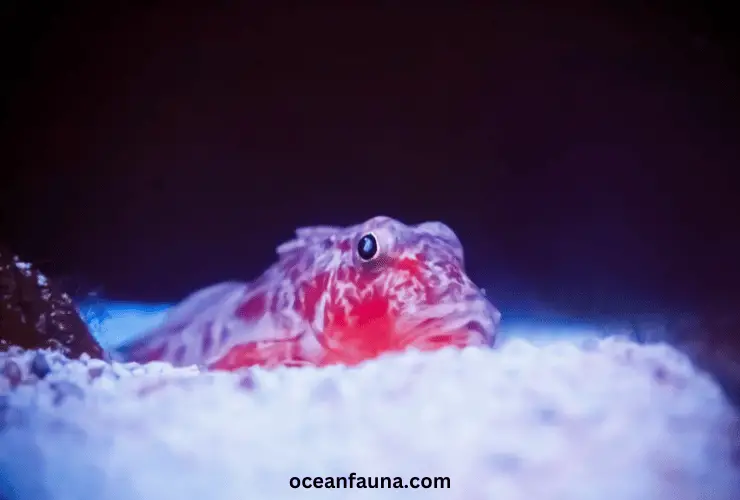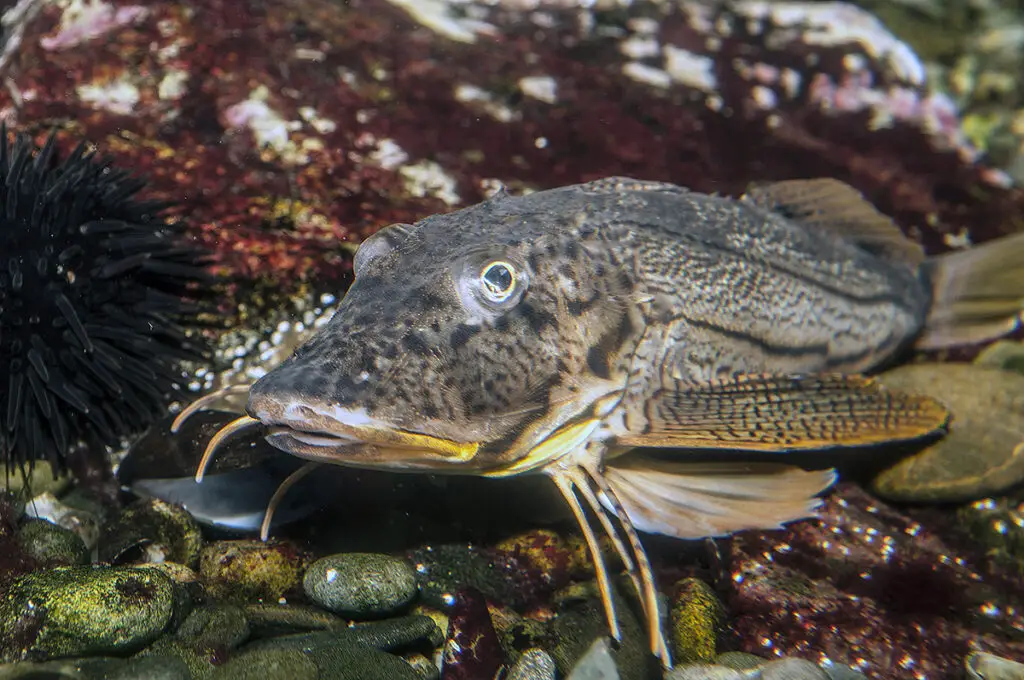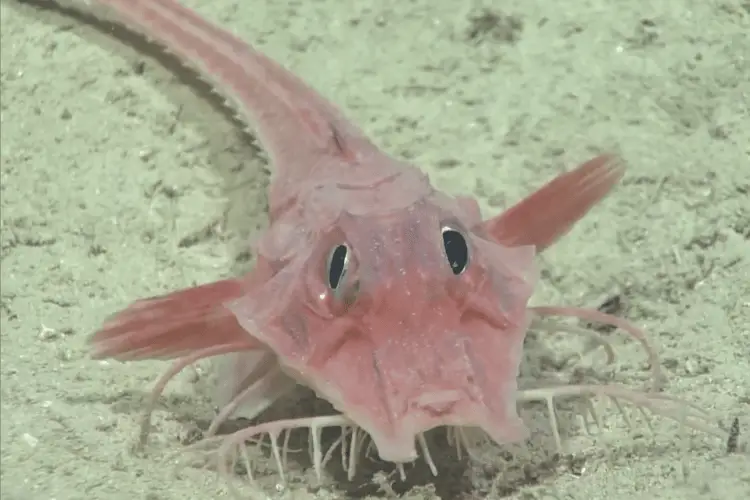Sea robins, or gurnards, are fascinating fish species in the Atlantic, Mediterranean, Black, and Baltic Seas. These fish belong to the Triglidae family, which includes bottom-dwelling fish. This species has a broad triangular head, prominent eyes, and large pectoral fins. Also, they tend to be reddish or brownish and grow up to 18 inches long.
One of the most distinctive features of sea robins is their elongated pectoral fins used for walking on the seafloor. They also have a unique way of feeding, which involves “picking” at their prey with their specialized jaw bones. Even from its spiny fins to its distinctive croaking sounds, there is much to learn about this intriguing creature.
Here, we will explore the fascinating life of the sea robin, including its physical characteristics, habitat, diet, and behavior. Also, this presentation will cover the sea robin’s biology, anatomy, and ecological role.

About Sea Robin – A Quick Biology
Here’s a quick look at this fish species.
| Parameters | Details |
| Scientific name | Prionotus carolinus |
| Kingdom | Animalia |
| Order | Scorpaeniformes |
| Class | Actinopterygii |
| Phylum | Chordata |
| Family | Triglidae |
| Genus | Prionotus |
| Species | carolinus |
| Habitat | Bottom-dwelling |
| Geography | Atlantic and Mediterranean |
| Lifespan | Up to 8 years |
| Diet | Crustaceans, mollusks, small fish |
| Size | Up to 18 inches |
| Synonyms | Cottus carolinus, Trigla carolinus |
Distribution (Where Do Sea Robin Live)
Around the world, you can find sea robins in various regions, especially in the coastal waters of the Atlantic Ocean. They are widely distributed along the eastern coast of North America, ranging from Newfoundland to Florida. Also, you will find them in New Jersey’s coastal inlets and harbors from Sandy Hook to Delaware Bay.
However, the Atlantic Ocean is home to several species of sea robins. Such as-
- The northern sea robin (Prionotus carolinus) is found from Canada to Mexico.
- North American striped sea robins (Prionotus evolans) live along the eastern coast
- Gulf sea robins (Prionotus ophryas) live in the Gulf of Mexico.
- South America is home to the longhorn sea robin (Prionotus longispinis).
- Common sea robins (Prionotus punctatus) live along the coasts of Europe, northern Africa, and the Mediterranean.
- There are yellow sea robins (Prionotus lutescens) in the eastern Mediterranean and the Black Sea.
There have been reports of sea robins in other regions worldwide, such as the Indian Ocean, the Western Pacific and the Southern Atlantic. In some areas, ballast water discharge and other methods have made them invasive species.
Habitat and Range
In general, Sea robins live in sandy or muddy areas, often near rocks or other structures where they can hide. They prefer to live at depths of more than 200 meters( 600 ft), but they can also survive at shallower depths.
Even, In the summer, sea robins breed, and adults stay in relatively warm water throughout the breeding season.
However, they are not typically found in water as warm as 71 degrees Fahrenheit. Instead, they survive in various temperatures depending on their geographical location and time of year.
Physical Characteristics/Anatomy
Several physical characteristics differentiate sea robins from other marine animals. Here are some key features of their anatomy:
Bony head
Sea robins have bony heads covered in tiny spines. It is often described as resembling a casque or helmet. As a result, this skeletal structure protects the fish’s brains and sensory organs. These are essential for detecting prey and predators.
Large eyes
They also have large eyes positioned on the top of their head. In the ocean, it allows them to see prey and predators above them while remaining camouflaged.
Size
Sea robins are relatively small fish, with most species reaching lengths of 12 to 18 inches. However, some larger species may grow up to 30 inches in length.
Pectoral Fins
One of their most distinctive features is the three lower rays of their pectoral fins. These are enlarged and free of the fin membrane. To find prey, sea robins probe into sediment using these specialized fins. These fins also create a current that stirs up sediment and reveals hidden prey.
Dorsal fins
They also have two dorsal fins. The first dorsal fin has between 7 and 11 spines, while the second has 10 to 23 soft rays. The anal fin may not have any spines, or it can have a single crest and 11 to 23 soft rays. Besides propulsion, these fins also help sea robins maintain their position in the water.
Gills
Sea robins have six-gill slits on either side of their bodies. The purpose of these slits is to extract oxygen from the water.
Mouth
Their mouth is large and lined with sharp teeth. Their structure allows them to capture and eat their prey.
Coloration
It’s typically reddish-brown. In a mottled pattern, it blends into the ocean floor. Their fins are also brightly patterned and decorated with spots and stripes.
Swim bladder
A swimming bladder in sea robins provides buoyancy in the water by storing gas.
Synesthesia
Sea robins use their pectoral fins to sense vibrations in the water. This is called synesthesia. Ocean animals use this sense to detect prey and navigate.
Skeleton
They have cartilage instead of bone for their skeleton. This is a common feature of many species of fish.
Scales
Sea robins have scales that are relatively small and smooth. There are fewer scales on sea robins than on other fish, which makes them more agile.
Behavior of Sea Robin

Here are some details about the behavior of sea robins:
Communication
They produce grunting or croaking sounds by contracting their swim bladder muscles. Sea robins use these sounds for navigation, communication and courtship.
Foraging behavior
They walk along the ocean floor using their pectoral fins to look for food as bottom-dwellers. They locate crabs, shrimp, and clams to feed on using their sensitive barbels.
Typical courtship behavior
When the mating season begins, male sea robins create circular depressions in the sand with their pectoral fins to defend their territories. The croaking sounds they produce attract females. Even they display courtship by erecting their dorsal fins and extending their pectorals.
Conduct of defense
In the event of a predator attack, sea robins have an unusual defense mechanism. They can make a loud noise that startles predators and allows the sea robin to escape.
Schooling behavior
When migrating or feeding, sea robins often school together in large groups. You may occasionally see schools of sea robins near the water’s surface. In shallow water, especially during low tide, they may become stranded.
Swimming behavior
They can swim short distances using their pectoral fins. They can also “fly” short distances by rapidly flapping their pectoral fins. It allows them to move quickly through the water and escape from predators.
Feeding Habits/Diet- Are Sea Robin Carnivores or Omnivores?
Sea robins are primarily carnivorous. They are not picky eaters and will consume almost anything they come across. Also, they are known to dig into the seafloor and pull out anything they find. These include seaweed and sand, as well as their usual prey.
Besides, opportunistic feeders will eat various prey, including crustaceans, mollusks, worms, and small fish. They use their strong, spiny pectoral fins to uncover buried prey items, such as clams and crabs. They also use their beak-like mouth to crush and grind the hard shells of their prey.
However, they have a unique method of detecting prey. Scientists have observed that they use their pectoral fins to sense the amino acids in other creatures’ bodies. It allows them to see prey on the sandy ocean floor through chemoreception. This ability helps them find and catch a variety of prey.
As they mature, sea robins become more specific in their diet. Nevertheless, young sea robins have a varied diet, especially those of the northern variety (Prionotus carolinus).
Reproductive Cycle

Sea robins have a complex reproductive cycle, breaking into several key stages. Let’s check it out!
Breeding season
The best time for sea robins to breed is from July to October in open areas near the seafloor. Adult sea robins migrate to shallow coastal waters and estuaries to mate and spawn during this time.
Egg production
Once the female sea robin is ready to lay her eggs, she will deposit them in sandy or muddy areas. Because here, they can be protected from predators and environmental stressors. The female lays hundreds or thousands of eggs in shallow water over several days. The eggs are triangular and are around 0.2mm to 1.0mm long.
Adult sea robins have no interaction with their young after laying their eggs. The larvae must fend for themselves and rely on their instincts and abilities to survive in their marine environment.
Fertilization
During mating, the male uses his modified pelvic fins, known as claspers, to transfer sperm to the female. This external fertilization process allows the eggs to be fertilized outside the female’s body.
Hatching
After fertilization, the eggs hatch within sixty hours under optimal conditions. The eggs will hatch in about 7-10 days. Then, the larvae will emerge and feed on plankton and tiny organisms in the water column.
As the larvae grow, they undergo metamorphic changes, including developing distinctive croaking mechanisms and spiny pectoral fins. Depending on environmental conditions, this process can take weeks to months.
Migrate to adult
As the larvae mature, they migrate to deeper waters and join adult sea robin populations. There is a close relationship between sea robin reproductive cycles and environmental factors, such as- including water temperature, food availability, and ocean currents.
Growth
When sea robin larvae have completed their metamorphosis and reached a specific size, they migrate to deeper waters and feed on more oversized prey items. Juvenile sea robins feed on small fish, crustaceans, and other invertebrates.
During this phase, they will experience rapid growth. Besides, they will also reach a size of several inches within the first year or two of life. As sea robins mature into adults, their growth rate slows down significantly.
They continue feeding on larger prey. The size of adult sea robins can vary depending on the species and region. But they generally range from 8 to 20 inches in length.
Ecosystem Effects
Sea robins play a vital role in their ecosystem as predators and prey. They control populations of small fish and invertebrates as predators. In contrast, as prey, they provide food for larger predators.
- As predators, sea robins help control small fish and invertebrate populations, which can ripple throughout the ecosystem.
- Usually, they feed on various prey items, including crabs, shrimp, and small fish, which regulates the benthic community.
- They are valuable prey for larger predators such as marine mammals and larger fish. It helps to support the larger ecosystem.
- When sea robins consume prey items, they break down and digest organic matter. After that, it releases nutrients, promoting algae and seagrass growth.
- Sea robins play a vital role in nutrient cycling within their ecosystem. It helps to maintain a healthy marine environment nutrition balance.
Predators – Who Eats sea robins?
Some predators of sea robins include larger fish species such as striped bass, bluefish, and flounder. Also, marine mammals like dolphins and seals are their predators. Seagulls and ospreys also prey on sea robins.
These predators use their speed, agility, and powerful jaws to catch and consume sea robins. Sea robins also rely on their distinctive spines to defend themselves. It makes them difficult for predators to catch.
Relationship with Humans
There is a mixed relationship between sea robins and humans regarding their behavior. Sea Robins and humans are generally indifferent to one another, with occasional exploitation.
However, in certain regions, especially in the Northeastern United States, they are harvested commercially and considered food fish. They are also sometimes used as bait for other species of fish. Sea robins are not as highly valued as some other species of fish. Some fishermen view them as nuisances.
This is especially true in areas where they are particularly abundant. Unlike other commercially valuable species, they can compete with them. Because of their unique appearance and behavior, Sea Robins have become popular as sport fish.
Some anglers enjoy catching them for the challenge they present. But, their sharp spines can cause injury if not handled properly. Moreover, sea robins play a crucial ecological role in the marine food web, acting both as predators and prey
Can You Eat Sea Robin?
Several countries worldwide consume Sea Robin, particularly in Asia and Europe. It is considered a delicacy in some regions and used in stews and soups.
Therefore, regarding taste, Sea Robin meat is mild, sweet, and white. Japan uses the bones of the Sea Robin to make soup or stock as they contain a significant amount of collagen, which gives the broth a thick, creamy texture.
They can be cooked in various ways, including grilling, broiling, baking, or frying. To avoid potential health risks associated with undercooked Sea Robin, ensure it is thoroughly cooked.
However, its bony structure makes its meat less commonly consumed than other fish species. To remove the bones effectively, carefully fillet and prepare Sea Robins.
If you want to try Sea Robin, purchase it from a reputable fishmonger. Look for fish with clear eyes, shiny skin, and a clean smell.
Is Sea Robin Venomous?
The short answer is no. While these fish have spiny fins and distinctive appearances, many wonders if they are venomous. Sea robins are not venomous; their spiny fins are used for defense rather than venom delivery.
However, handling a sea robin can still be painful, as their spines can cause puncture wounds and irritation. Sea robins are not generally considered dangerous to humans. It is recommended that anglers and fishermen handle these fish with care to avoid injury.
FAQs
What happens if you get stung by a Sea Robin?
If you get stung by a Sea Robin, it can be painful but not dangerous. The sting can cause swelling, redness, and irritation. In some cases, it may lead to an infection.
So, cleaning the affected area with soap and water and applying a cold compress to reduce swelling are recommended. In some cases, pain medication or antihistamines may be necessary.
However, prevention is the key to preventing accidents. So, wearing protective gear when handling Sea Robins can greatly reduce the risk of being stung. See medical attention immediately if you experience severe symptoms or an allergic reaction.
Are Sea Robin endangered?
No! They are not endangered species. Because their populations are stable and abundant. Fisheries do not target them, but they are often caught incidentally as bycatch.
According to the International Union for Conservation of Nature (IUCN), their population is stable and not at risk of extinction. Recreational anglers often catch them and they are also harvested for commercial purposes.
However, it is essential to note that overfishing or habitat loss can significantly impact their population and conservation. A long-term strategy is needed to ensure their survival.
How rare is a Sea Robin?
They are not considered a rare species. They are quite common in their range. Several recreational anglers catch sea robins. The meat is also commercially harvested for its sweet, mild flavor. Their unique appearance and fighting abilities make them popular catches.
Summary
The sea robin may not be the most well-known or popular fish, but its unique qualities make it fascinating. From its distinctive appearance to its unusual swimming style, the sea robin is worth learning about.
They are also commonly consumed around the world. As a result, it is a valuable resource for commercial and recreational fishermen.
Despite our continued exploration and appreciation of marine life, the sea robin reminds us of something. With proper management and conservation efforts, we can ensure the sustainability of this species. Besides, we’ll continue to learn from the wonders of the ocean.
